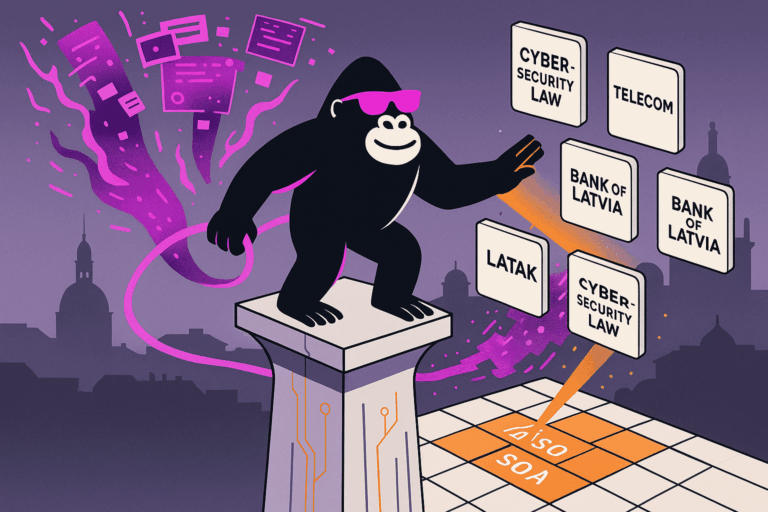A CISO’s role is no longer just about securing IT systems; it’s about protecting business value. Cyber threats evolve rapidly, and organizations that treat security as an afterthought often pay the price in downtime, financial losses, and reputational damage. Over the years, I’ve seen companies struggle with cyber risk not because they lacked technology, but because they failed to align security with business strategy, governance, and culture.
So how can CISOs effectively manage cyber risk? The answer lies in a proactive, structured approach that blends technical defenses with strategic risk management. Let’s break down the best practices that make a real difference.
Aligning security strategy with business objectives
Early in my career, I witnessed a well-funded security project fail simply because it was disconnected from business priorities. Security must align with an organization’s core goals, ensuring that efforts enhance rather than hinder operations.
Business-aligned security requires regular engagement with leadership. When security risks are framed in terms of business impact—such as minimizing downtime or protecting critical intellectual property—executive buy-in becomes easier. Additionally, integrating security at the inception of new projects prevents expensive and ineffective retrofits later.
| Business goal | Security alignment |
| Business continuity | Implement disaster recovery and incident response plans to ensure operations continue during cyber incidents. |
| Data integrity | Protect critical intellectual property and customer data to maintain trust and compliance. |
| Cost efficiency | Prevent financial losses from breaches and regulatory fines through proactive security investments. |
By embedding security into business strategy, CISOs can secure necessary funding and drive meaningful risk reduction. However, strategic alignment alone is not enough; a structured risk management framework is essential to identify and mitigate potential threats effectively.
PRO TIP
Translate security metrics into business outcomes to get executive buy-in.
When presenting to leadership, frame metrics like “MTTR” or “patch compliance” in terms of operational uptime, customer trust, or financial risk reduction. This shifts security from being a cost center to a business enabler.
Establishing a comprehensive risk management framework
I once worked with an organization that treated cyber risk as an afterthought—until a ransomware attack exposed its lack of preparedness. A structured risk management framework is essential to systematically identify, assess, and mitigate risks.
The key is adopting recognized frameworks like the NIST Cybersecurity Framework, ISO/IEC 27001, or COBIT, which provide structured guidance. Regular risk assessments should identify high-risk assets and potential threats, while a risk register documents risks, mitigation strategies, and accountability.
| Risk management component | Purpose |
| Risk assessment | Identify critical assets, potential threats, and vulnerabilities. |
| Risk register | Document and track identified risks, response plans, and ownership. |
| Risk appetite definition | Establish acceptable levels of risk in collaboration with leadership. |
A solid risk management framework provides a foundation for informed decision-making, but without a governance structure to enforce policies and track progress, risk management efforts can quickly become fragmented.
PRO TIP
Use heat maps during risk assessments to visualize business impact.
Risk heat maps help stakeholders quickly grasp which threats pose the greatest danger and require immediate mitigation, improving cross-functional engagement and prioritization.
Developing a governance structure
A lack of clear governance often leads to fragmented security efforts. One company I worked with suffered from inconsistent policies across departments, leading to security gaps that attackers could exploit.
A strong governance model includes forming a security governance committee with stakeholders from IT, legal, compliance, HR, and finance. This ensures security policies align with both regulatory requirements and business priorities. Additionally, key performance indicators (KPIs) like mean time to detect (MTTD) and mean time to respond (MTTR) help CISOs measure and improve security effectiveness.
| Governance element | Purpose |
| Security governance committee | Aligns security policies with business and regulatory requirements. |
| Defined security policies | Ensures consistent implementation across the organization. |
| Security KPIs | Measures effectiveness and identifies areas for improvement. |
With governance in place, CISOs can ensure policies are consistently applied across the organization. However, policies alone won’t stop cyberattacks—organizations need a layered security approach to defend against evolving threats.
PRO TIP
Assign risk ownership at the departmental level for faster policy enforcement.
Instead of centralizing all governance efforts under security, empower department heads to own and enforce applicable controls. This reduces bottlenecks and embeds accountability across the org.
Implementing layered security controls
No single security measure is foolproof. I’ve seen organizations over-rely on firewalls, only to suffer breaches due to weak endpoint security. Defense-in-depth ensures that if one control fails, others provide protection.
A Zero Trust architecture assumes that no entity should be trusted by default, continuously verifying users and devices. Network segmentation restricts lateral movement, reducing the impact of breaches. Additionally, continuous monitoring with anomaly detection ensures threats are identified before they escalate.
| Security layer | Function |
| Zero Trust | Ensures continuous authentication and least-privilege access. |
| Network segmentation | Limits lateral movement of attackers. |
| Endpoint security | Protects devices from malware and unauthorized access. |
| Continuous monitoring | Detects anomalies and potential threats in real-time. |
While technical controls provide robust defenses, human behavior remains a critical factor in cybersecurity. Without a security-conscious culture, even the most advanced defenses can be undermined by human error.
PRO TIP
Regularly test your defenses using red-team exercises aligned with real-world threat models.
Simulated attacks modeled after tactics used by threat actors in your sector reveal where layered defenses succeed—and where they break down.
Fostering a security-conscious culture
Technology alone cannot prevent breaches—people play a critical role. Social engineering remains one of the most effective attack methods, and without awareness, employees become the weakest link.
Organizations must invest in continuous security training, tailored to different roles. Encouraging employees to report suspicious activity without fear of reprisal fosters a culture of vigilance. Additionally, security champions within business units help promote best practices at a local level.
| Initiative | Benefit |
| Role-specific training | Ensures employees understand security risks relevant to their job. |
| Phishing simulations | Tests and improves employee resilience against email-based attacks. |
| Security champions | Embeds security awareness within different departments. |
A strong security culture reduces human risk, but organizations also need a robust incident response plan to mitigate damage when a breach inevitably occurs.
PRO TIP
Gamify security awareness to boost engagement and retention.
Leaderboards, digital badges, and rewards for spotting phishing attempts or completing training modules create positive reinforcement and higher participation across teams.
Building a robust incident response and resilience program
I’ve seen companies suffer massive reputational damage because they lacked a well-prepared incident response plan. A documented and tested incident response plan (IRP) ensures quick containment and mitigation when an attack occurs.
Tabletop exercises and red-team/blue-team drills help validate response procedures. Additionally, incident communication protocols ensure stakeholders—internal and external—receive timely and accurate information.
| Component | Purpose |
| Incident response playbook | Defines response steps for different types of incidents. |
| Regular testing | Ensures plans remain effective through simulated cyberattacks. |
| Communication strategy | Coordinates messaging with internal teams, regulators, and customers. |
While response planning is critical, staying ahead of threats through intelligence and proactive defense measures is just as important.
PRO TIP
Create role-based response checklists to ensure clarity during a crisis.
Each team—from legal to communications—should have predefined responsibilities. Checklists reduce confusion and speed up coordinated response efforts during high-pressure events.
Staying proactive with threat intelligence
Cybercriminals constantly refine their tactics. To stay ahead, CISOs must leverage threat intelligence feeds, conduct proactive threat hunting, and participate in industry information-sharing communities like ISACs.
| Approach | Outcome |
| Threat intelligence feeds | Provides real-time updates on emerging threats. |
| Threat hunting | Identifies sophisticated attacks that bypass traditional defenses. |
| Industry collaboration | Shares threat data to improve collective defense. |
By staying ahead of evolving threats, organizations can proactively fortify their defenses. However, third-party risk remains a significant concern, as attackers often target weaker links in the supply chain.
How CyberUpgrade empowers CISOs to lead with confidence and impact
CyberUpgrade isn’t just a cybersecurity platform—it’s a strategic partner for CISOs aiming to align security with business objectives and drive effective risk management. Our solution automates compliance workflows and risk assessments, delivering actionable insights that translate technical metrics into business outcomes. This enables CISOs to present clear, impactful reports to leadership, securing budget and support while demonstrating measurable risk reduction.
Our platform’s integrated risk register and governance tools help enforce accountability by assigning risk ownership across departments, reducing bottlenecks and ensuring policies are consistently applied. Coupled with automated threat intelligence, continuous monitoring, and CISO-as-a-Service expert guidance, CyberUpgrade equips security leaders with the resources to build resilient, layered defenses that adapt to evolving threats.
By partnering with CyberUpgrade, CISOs gain the ability to foster a security-conscious culture through built-in awareness training and streamlined incident response workflows—all while saving up to 80% of compliance effort. This comprehensive approach allows your organization to proactively manage cyber risk and confidently face whatever challenges lie ahead.
Continuous adaptation: the key to long-term resilience
Cyber threats are not static, and neither should a CISO’s strategy be. The most effective security leaders don’t just implement defenses—they continuously refine them, aligning security with business goals, adapting to emerging threats, and fostering a culture where security is everyone’s responsibility.
By integrating governance, layered security, proactive intelligence, and a strong risk management framework, organizations can stay ahead of attackers rather than merely reacting to breaches. The question is no longer if an attack will happen, but how well prepared your organization will be when it does. Are your defenses ready for what’s next?









